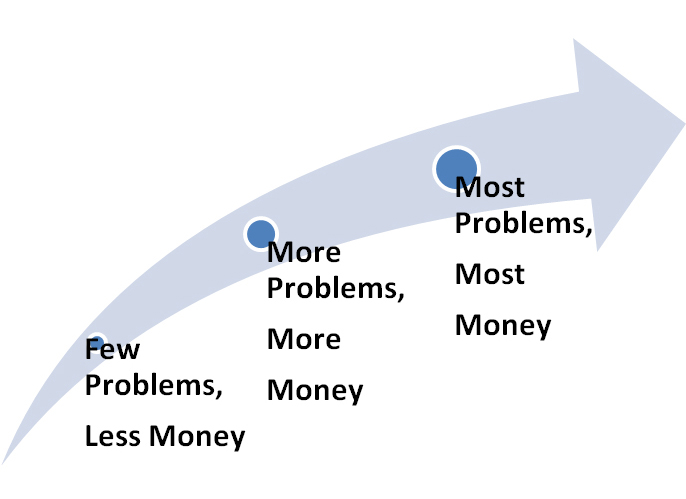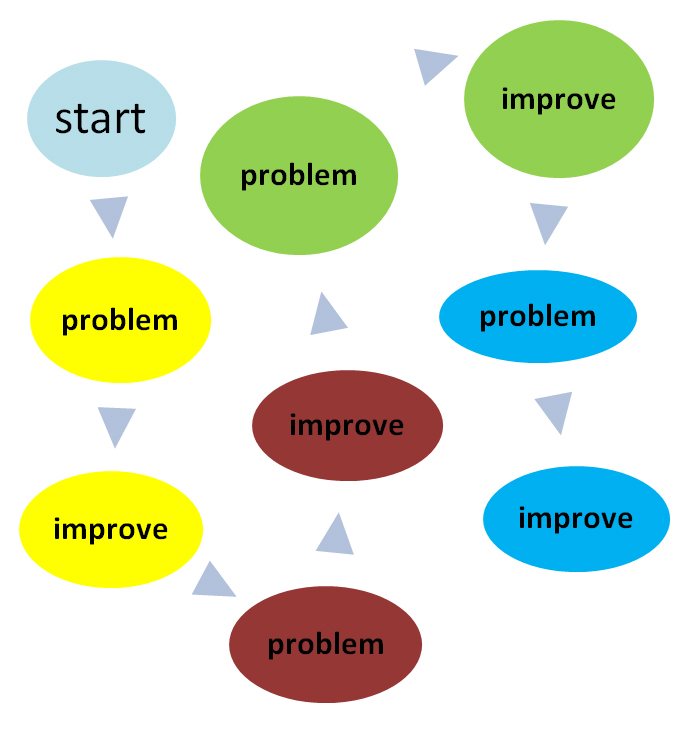Welcome to the LeanSchools™ eNews from the Oakland University Pawley Lean Institute. This is a monthly communiqué of the best in thinking for Lean schools. We invite you to read the information and realize that great strides can be made in the journey when you connect with others.
Culture Is a Cash Cow: Using a New Mental Model
Since thinking drives behavior, using mental models to better understand and improve thinking is a technique fundamental to improvement work. Many schools face the reality of no funding increases for the next 5-10 years, so the concern arises as to how to engage in improvement under these circumstances.
There is a common way of thinking founded on a mental model whereby co-dependence exists between problem identification and funding increases. This mental model forms the basis for relying heavily on funding as the answer to organizational problems. For example, in schools it is fairly common to identify a problem and then focus on allocating or obtaining additional funding to create new programs or to add to current programs as a solution. As the global economy falters, many schools now acknowledge that program creation as an intervention strategy is no longer reliable or viable since financial systems and funding sources are stretched to their limits. Relying on funds that are not available leaves many school organizations in gridlock with no means to implement new programs.
This way of thinking, the co-mingling of problem identification with increasing degrees of funding levels, is depicted in a mental model called “More Problems, More Money:”

Over time, reliance on funding as the sole source of improvement increases when this mental model is in use. There is a positive relationship between problem identification and funding. Such thinking often provides the most troubled systems with the most funding; since they have the most problems, they receive the most.
School districts and institutions of higher education are well aware of the limits of the More Problems, More Money mental model for it often results in “doing more of the same” by creating new layers to a distressed system, developing various protocols for checking or validating compliance work in a process with performance gaps, or increasing the allocated number of hours or staff to complete a project over deadline. By “doing more of the same,” the More Problems, More Money mental model essentially serves as the root of bureaucracy. Creating more departments to monitor lack of achievement, developing additional programs as remedial layers to a system that is not working, or providing more staffing to support an ineffective operating system, are examples of this paradigm’s behaviors. While it is critical to properly fund educational programming and to avoid creating unfunded mandates, this mental model goes beyond the need for appropriate and adequate funding. The essential idea of this mental model requires that adequate and appropriate funding is fairly secure for system maintenance and additional funding is the source of improvement. More Problems, More Money
relies on funding to expand current systems that are not working well. In other words, this mental model posits that that
funding solves problems.
In a recent article published by the Harvard Business School, “Ten Reasons to Design a Better Corporate Culture,” this popular mental model of More Problems, More Money is sufficiently unhinged by describing the financial and cultural benefits of promoting employee engagement as an improvement strategy.
http://hbswk.hbs.edu/item/5917.html
This article highlights that the best practices of organizational development foster employee productivity and innovation, a strategy of distinction and competitive advantage in the private sector. To put it bluntly, this article advances the simple concept that
culture is a cash cow. If this is true, then identifying a mental model for school leaders to advance this notion is needed. School leaders are posing this common question: How can we improve our schools without increasing funding?
The philosophy of Lean provides an answer by advancing a different mental model.
In Lean thinking, school leaders are challenged to focus on culture as a cash cow, so to speak, and to utilize a different mental model when faced with systems or processes that are not working. This mental model does require appropriate funding and does not support unfunded mandates, but it does not rely on increasing funding as the answer to improvement. This way of thinking, the co-mingling of problem identification with improvement, is depicted in a mental model called “More Problems, More Improvement:”

Engaging in problem identification as a means to improvement utilizes an iterative process when this mental model is in use. There is an ongoing and steady relationship between problems and improvement. Equal effort is put forth for problem identification and for improvement, matching the size and complexity of the problem with congruent improvement work. Such thinking provides the most distressed systems with the most improvement solutions; since they have the most problems, they receive the most attention for improvement. School districts and institutions of higher education are becoming aware of the value of the More Problems, More Improvement mental model as it often results in “doing less of the same” by creating focused improvements to a distressed system, developing various protocols for minimizing gaps and eliminating waste, or empowering currently allocated staff to provide improvement solutions for an inefficient system. By “doing less of the same,” the More Problems, More Improvements mental model essentially serves as the root of continuous improvement. It is critical to note that the importance of appropriate funding levels and the problems associated with unfunded mandates is not discounted in this mental model either. However, More Problems, More Improvement relies on improvement cultures for solving problems in current systems that are not working well. In other words, this mental model posits that that
people in a positive culture solve problems.
In the next months, most schools will cull through the possibilities for improving the educational system as outlined in the recent American Recovery and Reinvestment Act (ARRA).
http://www.ed.gov/policy/gen/leg/recovery/index.html
The intention of this funding package is to create both a shared commitment and shared responsibility for all education stakeholders, including K-12 public schools through higher education institutions, in order to improve the efficiency, effectiveness and relevance of these public education enterprises.
It is a shared national concern that education administration at all levels and in all venues is in need of alternative approaches that include more sophisticated critical-thinking techniques and useful tools designed to impact strategic and operational decisions. The use of new leadership paradigms based in Lean thinking and the mental model, More Problems, More Improvement, is one viable option. For those educational institutions applying for or receiving these funds and aligning with the intention of educational improvement, using a mental model like More Problems, More Improvement should be the selected approach.
Worth Reading
Levinson, W. A., & Rerick, R. A. (2002).
Lean enterprise: A synergistic approach to minimizing waste. Milwaukee, WI: ASQ Quality Press.
Given that culture is indeed a cash cow, this book is worth cashing in on. Levinson and Rerick emphasize that the successful venture into Lean draws upon far more than tools and techniques, it draws the corporate culture toward thinking and acting differently. If you are concerned about how such a magnanimous change is possible, the authors emphasize that the small inefficiencies are the very place to begin, and through the dynamic of small synergies, cultural change is indeed realistic.
Cash in on these golden nuggets from Lean Enterprise:
- "Lean enterprise is not merely a set of mutually supporting techniques, it is a change in the entire organization's culture and thought processes" (p. 21)
- Start with "friction or inefficiencies that are not serious enough to demand immediate attention but the collective effect of which can degrade the enterprise" (p. 36)
- "These techniques are synergistic and mutually supporting, not stand-alone actions that will deliver results by themselves" (p. xvi)
- "When frontline workers improve productivity themselves, cultural change occurs far more quickly" (p. 88)
Feel free to forward this information by e-mail to a friend as the LeanSchools community is a growing network of improvement champions!
All the best,
Shannon Flumerfelt
Kevin Brockberg



